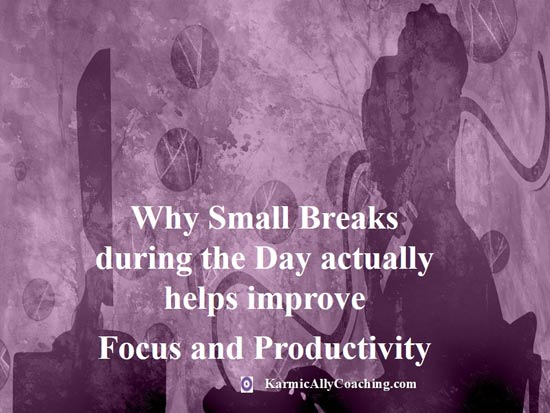This post has already been read 797 times!

Taking small breaks improved my focus and productivity while preparing for my 10th Grade Board Exams. Many of us were feeling overwhelmed with the study load and the importance of this exam. God Bless our class teacher who devised a system for us that worked.
We drew up a weekly timetable with different colors for each subject. Each subject was to be studied for 45 minutes and then switch to another subject.
I loved the idea of crossing out the boxes with a black marker pen as we went along.
But the clincher was the 15-minute breaks after every 2 study subjects. In other words, we got 15 minutes off after every 90 minutes of study.
The system worked and I topped my class without stress. Better still, the method still works after 40 years.
The only difference is my timetable is now on an Excel spreadsheet on my laptop. I still love crossing out the boxes!
Since then, I’ve learned some other strategies to go with this simple method helping me stay focused and efficient. And so can you.
The Dilemma of staying Productive in an Unproductive environment
We all want to be productive and efficient in the workplace. The good news is our bosses want that from us too.
The bad news? Even with the best of intentions, bosses sometimes can’t always create environments that facilitate productivity.
In the days when open office plans were the rage, the best they could do is tell you to work in the meeting room or if even work from home.
That doesn’t mean you can’t create your own productivity formula, though.
In fact, by taking small breaks regularly throughout the day you’ll be able to maintain your focus, thus being a more productive person.
I think our teacher knew that taking regular breaks during our study time would refresh our concentration and retention power. It would also help us to get more studying and revision done.
Years later, I found external evidence too in favor of regular breaks and even the duration of the break.
How often should these small breaks occur?
While there is wide range of opinions on this, there are 2 that answer this question.
MIT Sloan’s Robert Pozen recommends a break after 75 (to 90) minutes.
The Energy Project’s Tony Schwartz also recommends a break after 90 minutes.
Schwartz’s research shows that humans naturally move from full focus and energy to physiological fatigue every 90 minutes.
Our body sends us signals to rest and renew, but we override them with coffee, energy drinks, and sugar… or just by tapping our own reserves until they’re depleted.
That’s when we experience burnout and literally collapse.
While Schwartz suggests we purposefully take short breaks every 90 minutes throughout the day to drink water, walk, or to eat healthy snacks, even pausing to do a short meditation or power nap would do wonders.
I love his mantra is, “Pulse and pause.” It’s this idea of pulsing energy that’s behind the Pomodoro Technique developed by Francesco Cirillo.
With the Pomodoro method, you set a timer for 25 minutes, work on a single task with your full focus, then take a 5-minute break to get up, move around and maybe drink some water. Then, you repeat the cycle.
These experts believe that working for up to 90 minutes at a time will take advantage of the brain’s focus and consolidation modes.
Quite simply, there are 90 minutes of focus, and a 15-minute break allows your brain to consolidate and retain that information efficiently.
Not every position or schedule will allow you to take regular breaks at specific times. If this doesn’t describe your job, then simply take breaks where possible.
If someone is running late for a meeting, that’s your opportunity to grab five minutes to yourself.
That’s a technique I used in the office when leaving the desk for a full 15 minutes or so wasn’t possible. It also helped prevent a back problem or carpal tunnel syndrome in my hands.
I must point out that a lot depends on the culture of the company that you work for. Many owners and managers frown upon breaks.
We’ve gotten into this habit of scarfing down a quick lunch without even walking away from our desks.
All in the name of productivity. All to be seen to be doing the right thing. The right thing, though, for your health and your productivity, is to take your breaks!
The right way to take regular breaks
Plan to take a break at least every 90 minutes. If you want to be productive and maintain your focus, then you will protect your concentration by taking regular breaks.
The key lies in making the right decisions and not use it as an excuse to do wrong activities.
Resist every urge to hop online when you are supposed to be working. Don’t be tempted to check emails when you’re supposed to be focused on a project.
Another way to protect your focus is to resist eating junk at lunch. A burger may be quick, easy, and delicious, but it isn’t feeding your brain.
All of these decisions and choices that you can make throughout the day adds up to maintaining your focus and concentration.
It’s all about training your willpower and building up that muscle.
That, of course, includes those regular breaks.

The Pomodoro technique advocates for breaks after 25 minutes. Some experts suggest a break after 50 minutes.
That’s well and good if you work from home or have an understanding boss. 90 minutes is your goal.
It’s worth noting that DeskTime research found that the most productive employees worked 52 minutes (on average) before breaking for 17-minutes.

Why? It might be that we are more focused and remain focused because we know there’s a break coming.
If you think about a traditional working situation, then you know exactly how you lose focus as a break approaches.
Your body and brain are desperate to get to that break and you start to lose focus. You completely shut down and turn off, watching the clock for the magic number.
It’s different when you enjoy regular breaks. You don’t watch the clock because you are refreshing your concentration regularly. Try it out and see how much of a difference it makes.
Make those break time minutes matter. Most organizations have firewalls on their servers and internet so checking social media or watching puppy and kitten videos might be out.
Here are some better ideas:
Exercise: Do small workouts within your office space. If that isn’t possible, how about walking up and down the stairs for a few minutes?
Walking: Take a walk to clear your mind and get some genuine Vitamin D. This will improve your concentration powers too.
Chat with your colleagues: Research shows that employees who socialize are happier at work and are able to do as much as their non-socializing co-workers.
If you aren’t sure whether your boss will allow you to do this, you can try it at home with a project.
The difference it makes to your performance might be enough to help you convince your boss to make the change in the office.
Frequent breaks are part of the survival kit for every office worker – they can improve your eyesight, reduce back pain, arthritis, stress levels, and even the risk of heart disease.
Simply put, working non-stop for long periods of time can lead to cognitive boredom and that’s when we tend to make mistakes most.
The human brain isn’t able to focus for 8 hours at a time. Besides giving your mind a break, it gives you a chance to take advantage of the Zeigarnik Effect, another productivity hack.
More importantly, your body gets a chance to rest and even boost your productivity.
Isn’t that worth taking regular breaks?




 I adhere to the Certified Coaches Alliance Code of Ethics and Standards. A copy is available on request.
I adhere to the Certified Coaches Alliance Code of Ethics and Standards. A copy is available on request.
 Let's Talk through the Connect Form:
Let's Talk through the Connect Form: